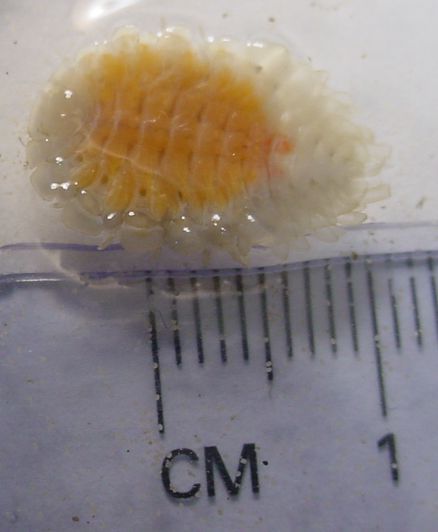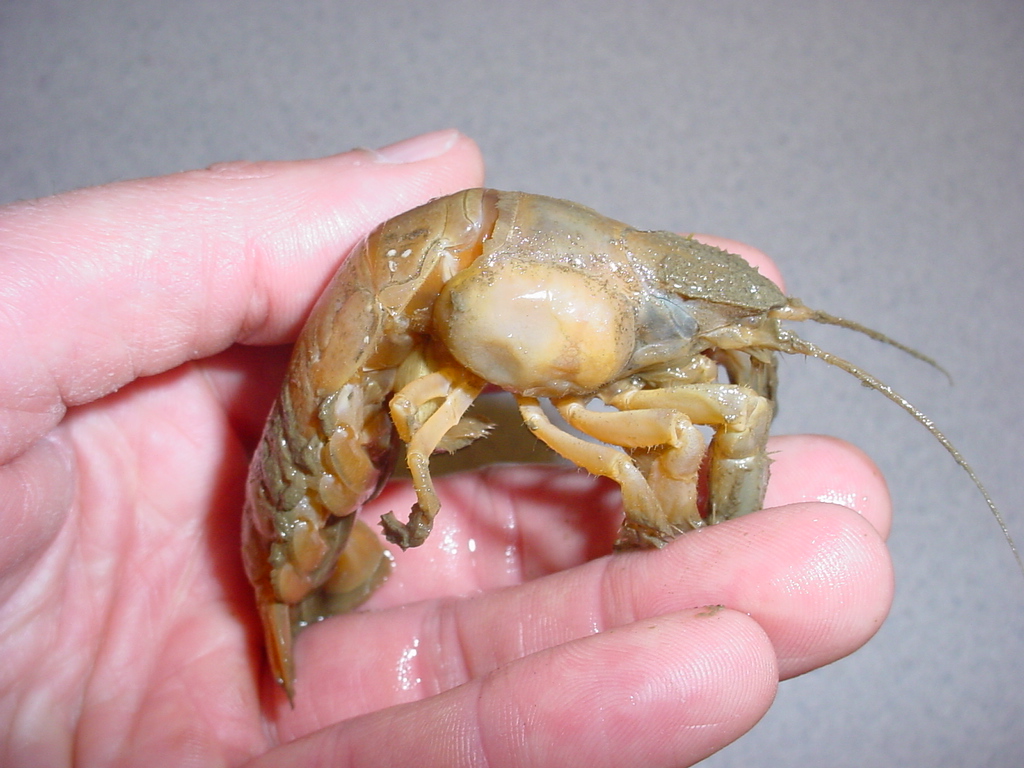Orthione griffenis Markham, 2004Common name(s): Upogebia gill isopod |
|
| Synonyms: |  |
|
Phylum Arthropoda
Subphylum Crustacea
Class Malacostraca
Subclass
Eumalacostraca
Superorder
Peracarida
Family Bopyridae
Subfamily
Pseudioninae
|
|
| Dorsal view of Orthione griffenis female removed from the gill chamber of Upogebia pugettensis (see below). The ovaries are orange and large because she is packed full of eggs. Her head is to the left. | |
| (Photo by: Dave Cowles, summer 2005) | |
Description (from Markham, 2004 original description): Epicaridean isopods are parasitic on crustaceans, and this genus (Orthione) is found on Upogebia mud shrimp gills (Photo). Genus Orthione females have an oblong body, about twice as long as wide, with sides nearly parallel and the longitudinal axis only slightly distorted. All body regions and segments can be distinguished from the dorsal side (see photo above). The head is deeply set into the pereon and its anterior margin is completely covered by a frontal lamina. The outline of the margin of the head forms a continuous curve with the margin of the pereon. The maxilliped does not have a palp. The pereopods are slightly to much larger posteriorly than anteriorly. The oostegites enclose a large ventral brood pouch in which eggs or larvae are brooded. The first oostegite has a prominent but unadorned internal ridge and no posterolateral point. The pleon has 6 pleomeres which are much wider than long. The 6th pleomere is deeply enclosed by the 5th. The 5 pairs of biramous pleopods and the uniramous uropods completely cover the lateral margins and all but the center of the pleon. The endopodites of the first pair of pleopods is larger and extends farther medially. Males in genus Orthione have an oblong body at least 3x as long as wide. All body regions and segments are distinct. The head is nearly semicircular and the 2nd antennae are prominent and extended. The small pereopods are clustered medially, and are somewhat larger but with smaller dactyls posteriorly. The pleon is about 1/3 the total body length and has 6 pleomeres. Pleopods are absent or as incomplete uniramous flaps. The 6th pleomere is mostly surrounded by the 5th and bears uniramous flaplike uropods. Orthione griffenis females have cups on the propodus of their pereopods into which the tips of the dactyls are inserted. The bases of the propodal cups are produced into large carinae. The rami of their pleopods are ovate. The holotype is 11 mm long and 9.2 mm wide (at pereomeres 4-5). Its head is 2.2 mm long and 2.1 mm wide. The pleon length is 2.9 mm. It is distorted (twisted) about 15 degrees to the right. It has no pigmentation. Its first antennae are long and extend beyond the margin of the head but the 2nd are short. Pereomeres 1 & 2 curve around the head, pereomeres 3-4 are nearly straight, and pereomeres 5-7 curve posteriorly. All pleomeres are strongly concave posteriorly. The male allotype is 8 mm long and 3 mm wide (at pereomere 6). Its head is 1.1 mm long and 1.9 mm wide. The pleon is 2.7 mm long. Its body is straight on both sides, and rounded at the front and back. The pereomere segments are clearly distinguished by anterolateral notches along the lateral margins. It has no pigmentation.
How to Distinguish from Similar Species: All other females of genus Orthione currently described do not have the propodal cups into which the dactyls of their pereopods insert and the rami of their pleopods are lanceolate.
Geographical Range: British Columbia to Baja California. Introduced from Asia.
Depth Range:
Habitat: Parasite in the gill chambers of Upogebia pugettensis along our coast and in other species of Upogebia elsewhere.
Biology/Natural History: This is the first known example of an invasive bopyrid species. It probably arrived on the US west coast in ballast water. Its first recorded occurrence on the west coast was from Willapa Bay in 1988 (Chapman et al., 2012). By 1992 it was found in Morro Bay in central California, in southern Puget Sound in 1995 and Coos Bay in 1997. It does not appear to infest Upogebia pugettensis individuals of less than 12 mm carapace length (Smith et al., 2008).
This isopod is said to be much more common on Upogebia pugettensis females than on males (Smith et al., 2008). Bopyrids frequently have a castrating effect or reduction of reproductive potential on females. This species is also suspected of feminizing males, and likely also has a metabolic burdening effect on its Upogebia host. It appears to have caused the local collapse of many local populations of Upogebia. Asson et al. (2017) explored several potential explanations for the dramatic population reductions of Upogebia after infestation with this parasite (Griffen, 2009; Repetto and Griffen (2012), based on an examination of 2,014 individuals from several Oregon estuaries, including 508 individuals parasitized with Orthione griffenis. Sixty seven percent of the infested individuals, a 2:1 ratio, were females. However, females tend to be larger than males and infestations are much more common in large individuals of both sexes so it is not clear whether the 2:1 ratio is because the isopods preferentially infect females or large individuals. They found no greater incidence of intersex individuals in parasitized individuals, thus not supporting feminization of males. Intertidal location of the burrows did not affect male/female prevalence of infestation although there was a slightly higher abundance of infestation at the lowest tide levels. They suggested that the greater prevalence of infection among female Upogebia could be explained if Upogebia females grow to larger size more quickly and live longer than males do. The effective castration of females by energy loss to the parasite was also supported by their data.
My thanks to Andy Cohen and John Chapman for help with
information on
this page. This species was named after Blaine D. Griffen.
| Return to: | |||
| Main Page | Alphabetic Index | Systematic Index | Glossary |
References:
Dichotomous Keys:Carlton, 2007 (as O. griffensis; mentioned and illustrated but not in the key)
General References:
Scientific Articles:
Asson, Danielle; John W. Chapman, and Brett R. Dumbauld, 2017. No evidence that the introduced parasite Orthione griffenis Markham, 2004 causes sex change or differential mortality in the native mud shrimp Upogebia pugettensis (Dana, 1852). Aquatic Invasions 12:2 pp 213-224. https://doi.org/10.3391/ai.2017.12.2.09
Chapman, John W., Brett R. Dumbauld, Gyo Itani, and John C. Markham, 2012. An introduced Asian parasite threatens northeastern Pacific estuarine ecosystems. Biological Invasions 146: pp 1221-1236
Dumbauld, B.R., J.W. Chapman, M.E. Torchin, and A.M. Kuris, 2011. Is the collapse of mud shrimp (Upogebia pugettensis) populations along the Pacific coast of North America caused by outbreaks of a previously unknown bopyrid isopod parasite (Orthione griffenis)? Estuaries and Coasts 34:2 pp 336-350
Griffen, Blaine D., 2009. Effects of a newly invasive parasite on the burrowing mud shrimp, a widespread ecosystem engineer. Marine Ecology Progress Series 391: pp 73-83
Repetto, Michele, and Blaine D. Griffen, 2012. Physiological consequences of parasite infection in the burrowing mud shrimp, Upogebia pugettensis, a widespread ecosystem engineer. Marine and Freshwater Research 63:1 pp 60-67. https://doi.org/10.1071/MF11158
Smith, Andrew E., JohnW. Chapman, and Brett R. Dumbauld, 2008. Population structure and energetics of the bopyrid isopod parasite Orthione griffenis in mud shrimp Upogebia pugettensis. Journal of Crustacean Biology 28: pp 228-233. https://doi.org/10.1163/20021975-99990368
Markham, John C., 2004. New species and records of Bopyridae (Crustacea: Isopoda) infesting species of the genus Upogebia (Crustacea: Decapoda: Upogebiidae): the genera Orthione Markham, 1988, and Gyge Cornalia & Panceri, 1861. Proceedings of the Biological Society of Washington 117(2): 186-198 (original description of the species, along with a short key to distinguish Orthione species)
Web sites:
General Notes and Observations: Locations, abundances, unusual behaviors:
I believe I observed this parasitic isopod on U. pugettensis in Padilla Bay in 2004. The photos here were taken in 2005, also from a specimen from Padilla Bay. Very few if any U. pugettensis can be found in the region since 2005. This is consistent with the observed collapses of the population elsewhere after infestation with this parasite.

In this ventral
view of the isopod some of the orange ovaries can also be seen. The
bulging
underside of her pereon
is due to the bulging oostegites.
She likely is brooding 40,000 to 80,000 larvae inside, besides the eggs
developing in her ovary. A smaller male (not pictured) was also likely
originally present and clinging to her.

Here is a view of the isopod within Upogebia's
pugettensis' gill chamber before I removed it.
Photo by Dave
Cowles, summer 2005
Authors and Editors
of Page:
Dave Cowles (2018): Created original page
CSS coding for page developed by Jonathan Cowles
Salish Sea Invertebrates web site provided courtesy of Walla
Walla University